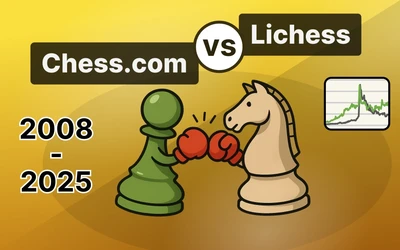
Calculate until the end.. and one move more!
Blunder or brilliancy, sometimes it all hinges on one more move.You’ve calculated everything, or so you think. The tactical line seem to favour you, but have you actually seen the variation until the end? Or just the part that felt like the end?
When calculating long and sharp lines, we tend to stop calculating once the forcing moves are over and the position reaches calmer waters. The change in sharpness seems to be a suitable point for us the end our calculations and start evaluating whether we want to enter the variation or not. However in some messy positions, the final twist only comes after the move where most players stop calculating. And that twist can change the entire evaluation from a promising combination to a cold refutation, or from a dismissed idea to a game-winning shot.
As we will see from the examples from this article, it pays to get into the habit of calculating just one more move after what seems to be the end of the variation. Lets demonstrate this using a famous example:
Introductory example: White to play. Try to calculate can white get away with 1.Rxc5? There is a discovered attack motif via Bxf7+, but white must ensure they end up on top after the end of the complications. (note the critical line is if Black answers Bxf7+ with ..Kh8)
This is a very instructive example. Whites combination does not make sense until the 5.Qh5! fork, but many players would have stopped calculating the variation before even considering 5.Qh5! That’s the entire point of this article. I have found 3 interesting and instructive examples from my own games where a game-changing move only appeared after I had ended my calculations.
This article is a continuation to my previous articles “Reverse your move order”, "Pinned pieces don't defend" and “Dont forget about backward moves” all which focus on good calculation habits, so I highly recommend you to check out those articles as well if you haven’t already.
For the below examples I will suggest the first move of a tactical sequence. Your task is to calculate the entire variation and evaluate if the combination is favourable or not. Try to calculate one move further than your instincts tell you to.
If you find it hard to visualise several moves ahead, don’t worry. You can play out the first few moves and then calculate the rest. When you see the entire line go back and try to visualise the whole variation from the original position in your head. This is great for calculation training too.
Position 1: White to play. Here I have a decent position as White, but Black can quickly consolidate if he can e.g. get moves like Ne5 and Bc4 in. Threats against h7 is easily defended by Bg8. However there is a potential back rank tactic in the position. Can White get away with 1.Qxc6?
Well done if you were able to see the refutation 4..Qc1+ from afar! You did better than me, as I stopped calculating once I saw 3.Bb3, thinking the complications have ended here and that I’m getting 3 pieces for the Queen. Qc1+ was not a difficult move to find if we actually look for it, so clearly, building in the habit of checking for one more move at the perceived end of the variation would have prevented this loss.
Position 2: White to play. This examples shows this principle also applies in the endgame. As white I should be able to hold this position since Blacks f3 pawn is very weak. But there is a Knight Fork motif in the position we must evaluate. Does the combination beginning with 1.Rxa6 work in below position?
It is easy to fall into the trap of ending the variation after 4.Nxa6. After all the combination is over and we won a pawn. But more move reveals the disaster, our knight is trapped! 4..Bd6 is again not difficult to spot if we stayed alert from the initial position!
Position 3: White to play. The final example was a shocker for me because it seems like a straightforward position and a short combination. Qf5 is well-met by Nf8, but I see a tactic lurking based on the loose piece (Nd7). Can White play 1.Bxh7+?
No we cannot play Bxh7+! My little combination ended with 3.Qxd7, and I saw no reason to calculate further thinking nothing more is going on. This really illustrates importance of calculating one more move before ending the variation, even if the forcing moves are over. Because now the immediate 3..Re6! traps my Queen! I did not imagine losing my queen after only a few moves from the initial position. Chess is hard enough. But harder if you stop calculating too early.
Concluding thoughts: One more move
I hope these examples show just how much depth can be hidden in the moves we don’t bother to calculate. Sometimes the decisive detail lies not in the obvious blows, but in the stillness that follows them. When you teach yourself to push just one move deeper, you’ll start seeing ideas others overlook.
It’s a small habit with a big payoff because sometimes, that additional move is not just an afterthought, it’s the entire punchline.
I hope you have enjoyed this article! You’ll find many more like it on www.chessinprogress.com, where this piece is part of my ongoing project to write 100 tactical and strategic lessons for the ambitious player. Its just about sharing chess lessons. Everything there is open-access. It's just pure chess lessons, shared for the love of the game. Hope to see you there!
You may also like
 FM MathiCasa
FM MathiCasaChess Football: A Fun and Creative Variant
Where chess pieces become "players" and the traditional chessboard turns into a soccer field Mcie
McieX-Ray Attacks: Hidden Pressure, Sudden Impact
Scan for the indirect contact ChessMonitor_Stats
ChessMonitor_StatsWhere do Grandmasters play Chess? - Lichess vs. Chess.com
This is the first large-scale analysis of Grandmaster activity across Chess.com and Lichess from 200… CM HGabor
CM HGaborHow titled players lie to you
This post is a word of warning for the average club player. As the chess world is becoming increasin… IM HelloItsDmitri
IM HelloItsDmitriWhat are pawns used for in chess?
It has been said that pawns are the soul of chess. But what exactly is the job of the weakest, yet m… Mcie
Mcie